Home / Molecular Orbitals of The Allyl Cation, Allyl Radical, and Allyl Anion
Dienes and MO Theory
Molecular Orbitals of The Allyl Cation, Allyl Radical, and Allyl Anion
Last updated: December 18th, 2024 |
How To Draw The Molecular Orbitals of The Allyl Cation, Allyl Radical And Allyl Anion
Drawing the molecular orbitals of a pi system like allyl (3 conjugated p-orbitals) is a bit like construction: build the house (orbitals) first, and fill it with people (electrons) second.
- When the two p-orbitals of a pi bond can overlap with a p-orbital on an adjacent carbon, the resulting “pi-system” containing 3 p-orbitals is referred to as the allyl pi system
- The allyl cation has 3 p-orbitals and two pi-electrons
- The allyl radical has 3 p-orbitals and three pi-electrons
- The allyl anion has 3 p-orbitals and four pi-electrons
- Drawing out the molecular orbitals of each of these systems can be done in a stepwise manner.
- The lowest-energy molecular orbital (π1 ) will have all three p-orbitals aligned with the same phase and zero nodes
- The highest-energy molecular orbital (π3) will have all three p-orbitals with opposite phases and two nodes.
- The intermediate energy molecular orbital has one node that is on the central atom.
- Once the molecular orbital diagram is drawn, the next step is to fill it with pi-electrons: two for the allyl cation, three for the allyl radical, and four for the allyl anion.
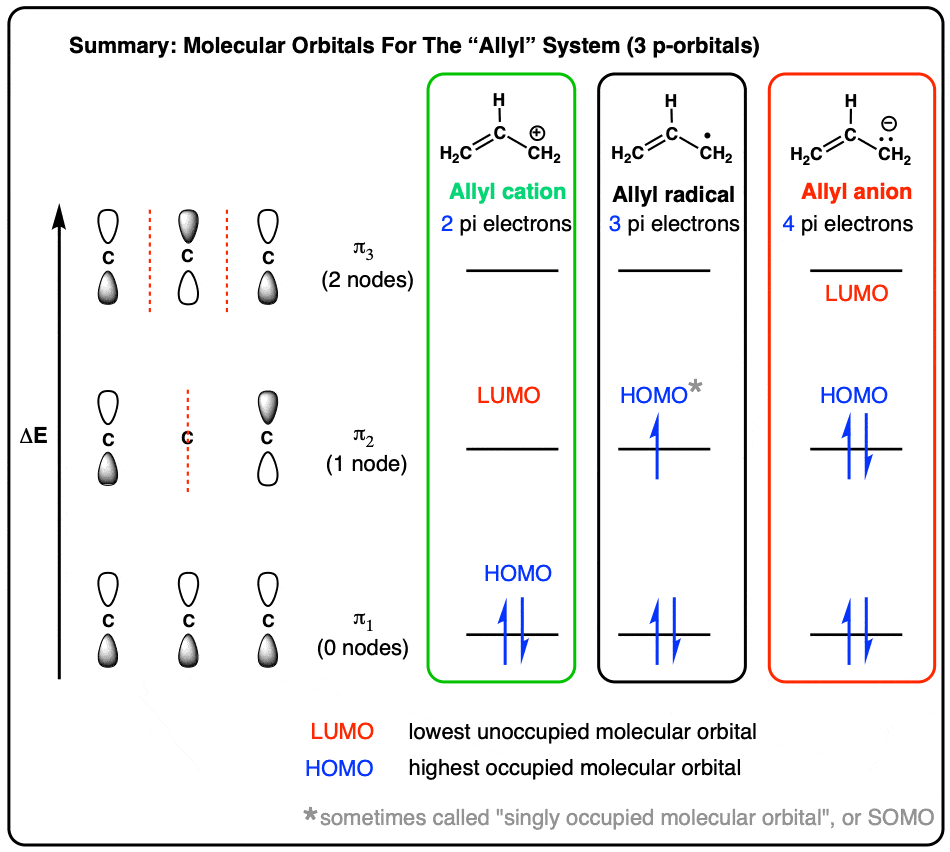
Table of Contents
- Quick Review: Molecular Orbitals For A Simple Pi Bond
- The Rules For Building Up Pi Molecular Orbital
- The Allyl Cation, Allyl Radical, and Allyl Anion
- The Molecular Orbitals For The Allyl System (N=3)
- The Tricky Middle Orbital Of The Allyl System
- Molecular Orbitals of The Allyl Cation (2 pi electrons)
- Molecular Orbitals of the Allyl Radical (3 pi electrons)
- Molecular Orbitals of the Allyl Anion (4 pi electrons)
- Conclusion: The Allyl System
- Notes
- (Advanced) References and Further Reading
1. Quick Review: Molecular Orbitals For A Simple Pi Bond
In the last post, we showed how to build a molecular orbital (MO) diagram for a typical C-C pi bond.
We saw that:
- The number of molecular orbitals equalled the number of contributing atomic orbitals. The overlap of two atomic (p) orbitals gave rise to two molecular (pi, or π ) orbitals
- The lowest-energy molecular orbital had all the phases in the contributing p-orbitals aligned the same way. In other words, there were no nodes between the p-orbitals.
- Energy increases with the number of nodes (just like for standing waves). The highest-energy molecular orbital had a single node, where the p orbitals changed phase between each other.
The molecular orbitals for a pi bond look like this:
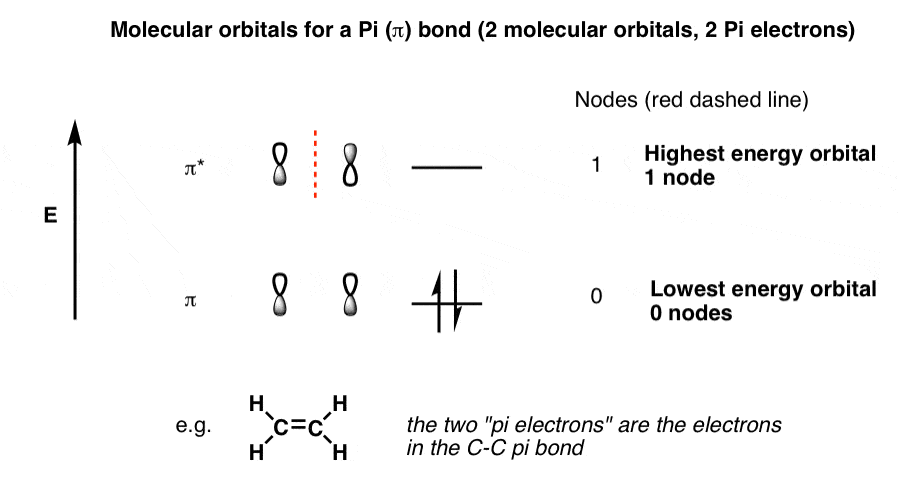
Drawing out the molecular orbitals for a single pi bond seems simple enough. But what happens to the molecular orbital diagram if we add a third contributing p-orbital? Or if we have an adjacent double bond, contributing 2 further p-orbitals, giving us 4 conjugated p orbitals in total? Understanding what happens to the molecular orbitals will allow us to understand their energies, and (as we’ll see later) their reactivity.
2. Generalizing The Rules For Building Up Pi Molecular Orbitals
We can use the lessons learned during building up the molecular orbitals of the pi bond to generalize toward building up larger (linear) pi systems containing N molecular orbitals. [Note 1]
- For a system of N atomic obitals we will have N molecular orbitals
- the lowest-energy orbital will always have zero nodes (all phase-aligned)
- The next-highest energy level up will have one node
- the level after that, two nodes,
- and so on, up to the highest energy level, which will have N-1 nodes (all of alternate phase)
Two key lessons, really. First, the number of p orbitals tells you the number of pi orbitals. Second, the lowest and highest energy orbitals are the easiest to draw: the lowest energy one will have phases all aligned, and the highest energy one will have phases all alternating. We’ll be using this generalization a lot.
So let’s take this to the next level. Three molecular orbitals. We call this the allyl system. Let’s go!
3. The Allyl Cation, Allyl Radical, and Allyl Anion
You’ve heard of methyl, ethyl, propyl, and butyl; our name for the three carbon unit H2C=CH-CH2 is “allyl“. Allyl alcohol, for example, is H2C=CH-CH2OH .
By now you’ve likely encountered the allyl cation, the allyl radical, or the allyl anion? Maybe you’ve learned that the allyl cation is a “resonance-stabilized” carbocation, or the allyl radical is a “resonance stabilized” radical?
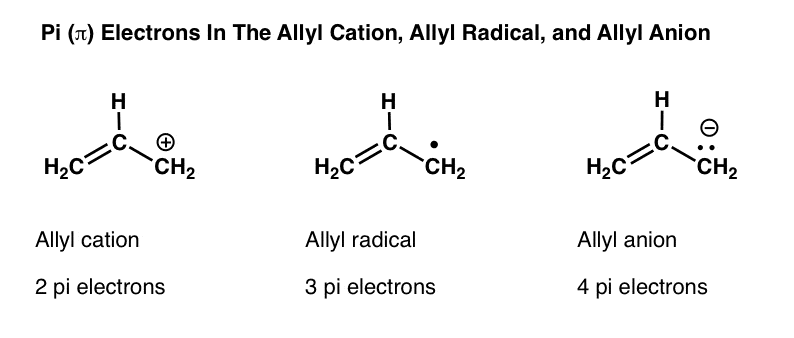
In each of these “pi systems” the allyl carbon has an available p-orbital that is conjugated with the adjacent pi bond. Another way of saying the same thing is that the allyl carbon is in resonance with the pi bond, such that we can draw resonance structures of each of these molecules. [We won’t do that again here: we covered it two posts ago, in this post on conjugation and resonance – if you need a refresher, go back and read it to re-familiarize yourself with conjugation, resonance, and orbital overlap. ]
Since the allyl system has three p-orbitals that are in conjugation, how many Pi molecular orbitals will it have?
Three. (N=3)
Next question. What will those three pi molecular orbitals look like? Say you’re asked the following question:
“Draw the molecular orbitals of the allyl cation, the allyl radical, and the allyl anion.”
(a common enough exam question, believe it or not!).
How would you approach that?
The allyl cation, radical, and anion all utilize the same framework of molecular orbitals. They only differ in the number of pi electrons they possess (2, 3, and 4, respectively).
Knowing that, we can divide this problem into two stages.
- First, draw the orbitals themselves.
- Second, populate the orbitals with the appropriate number of pi electrons.
Let’s do this.
4. The Molecular Orbitals For The Allyl System (N=3)
Draw the lowest-energy and highest-energy orbitals first
We’ll start by drawing the orbitals. The two easiest to draw are the lowest-energy and highest-energy orbitals, so let’s do those first.
- The lowest-energy molecular orbital will have complete alignment of the phases in the p-orbitals, and zero nodes between them. Let’s call this “π1“, the lowest-energy pi molecular orbital. [We could alternatively have drawn the “shaded” phases all on top: it amounts to the same thing].

- The highest-energy molecular orbital is also easy to draw: all the phases will alternate, giving it (N-1) = 2 nodes. We can call this “π3“, the highest-energy pi orbital of the three. The nodes are marked with red lines.

5. The Tricky Middle Orbital Of The Allyl System
What about the middle orbital, π2 ? It should have one node, and be intermediate in energy between π1 and π3
Where to put that single node? If you’re like I was, your first temptation for drawing the orbitals will likely be to put a node between one of the carbons, giving orbitals that look something like this:
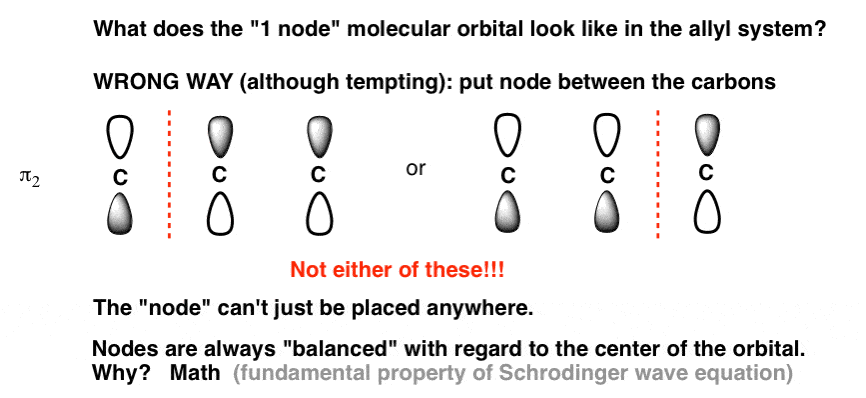
It’s actually incorrect!
Why? That’s a good question, and the answer isn’t obvious. It turns out that because of the way the math works in the Schrodinger equation, the nodes are always “balanced” with respect to the centre of the orbital. The node can’t just be placed anywhere; when there is one node, it must be in the centre. [By the way, this is a general feature of MO’s where the number of contributing orbitals is odd, e.g. N=3, N=5, N=7… the first node will be on the central carbon.]
The Node Goes In The Middle!
That means that the node is directly on that middle carbon.
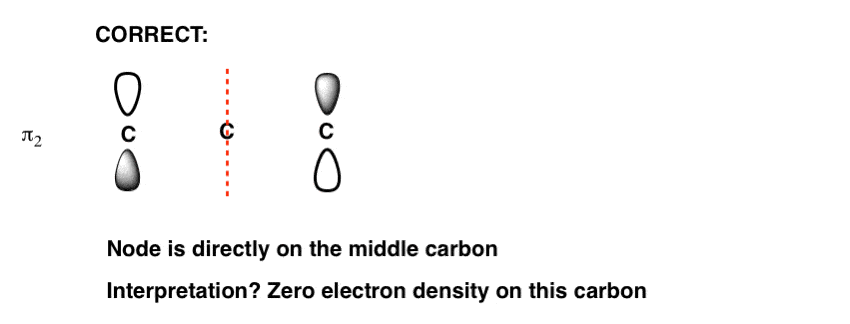
Weird, right? What does that actually mean? It means that in that molecular orbital there is zero electron density on that central carbon. We don’t need to go into further detail for our purposes, but I’m including a note where it gives us some clues about reactivity. [Note 2]
Now, if we arrange these orbitals together by energy (most stable at bottom) we get the following orbital diagram for the allyl system.
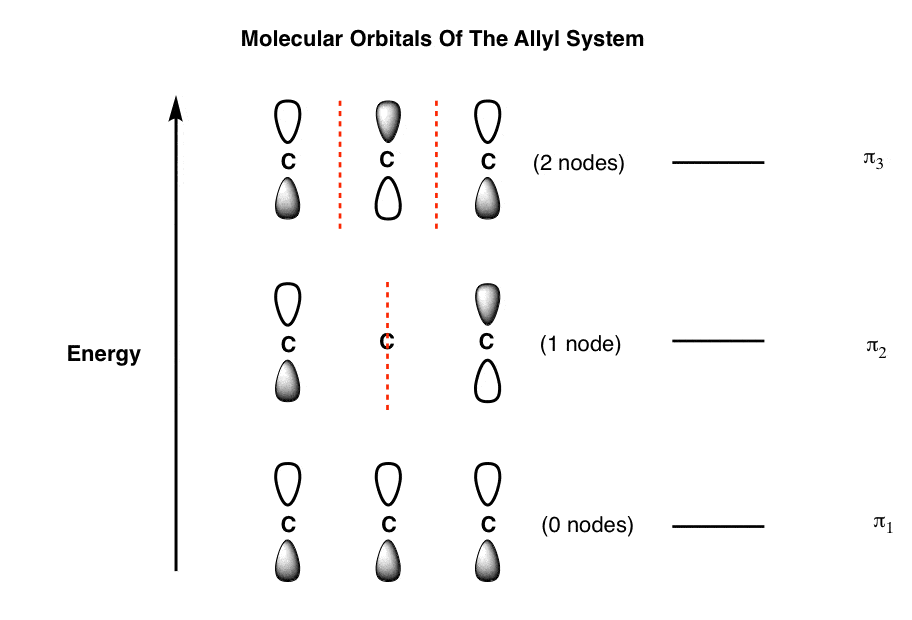
This is just the framework for the orbitals in the allyl system. It’s not specific to the allyl cation, radical, or anion yet, because those three species differ in the number of Pi electrons they possess.
Now, let’s populate the orbitals with electrons.
6. Molecular Orbitals of The Allyl Cation (2 pi electrons)
In the allyl cation we have 2 pi electrons in total: in the resonance form below, we see two electrons in the pi bond, and zero on the allyl carbon.
When we populate our allyl orbitals with two electrons, building from the ground floor up, we get the following:
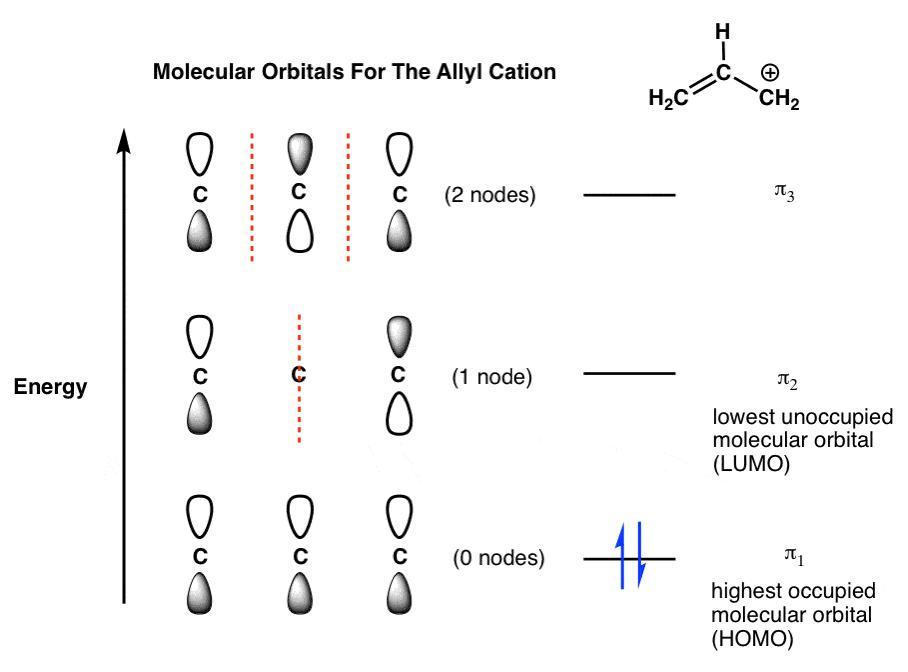
Note that the “highest occupied” molecular orbital of the allyl cation is π1 – the lowest-energy orbital in the system. The “lowest unoccupied” molecular orbital is π2 .
We generally abbreviate the terms “highest occupied molecular orbital” as HOMO and “lowest-unoccupied molecular orbital ” as LUMO. They are often called the “frontier” molecular orbitals and are where most of the action happens in reactions, as we’ll see in future posts.
7. Molecular Orbitals of the Allyl Radical (3 pi electrons)
What about the allyl radical? Here we have 3 pi electrons: two in the pi bond, and a third one in that half-filled p orbital.
Where do we put that third electron? In the next-highest orbital, of course. Into π2 it goes!
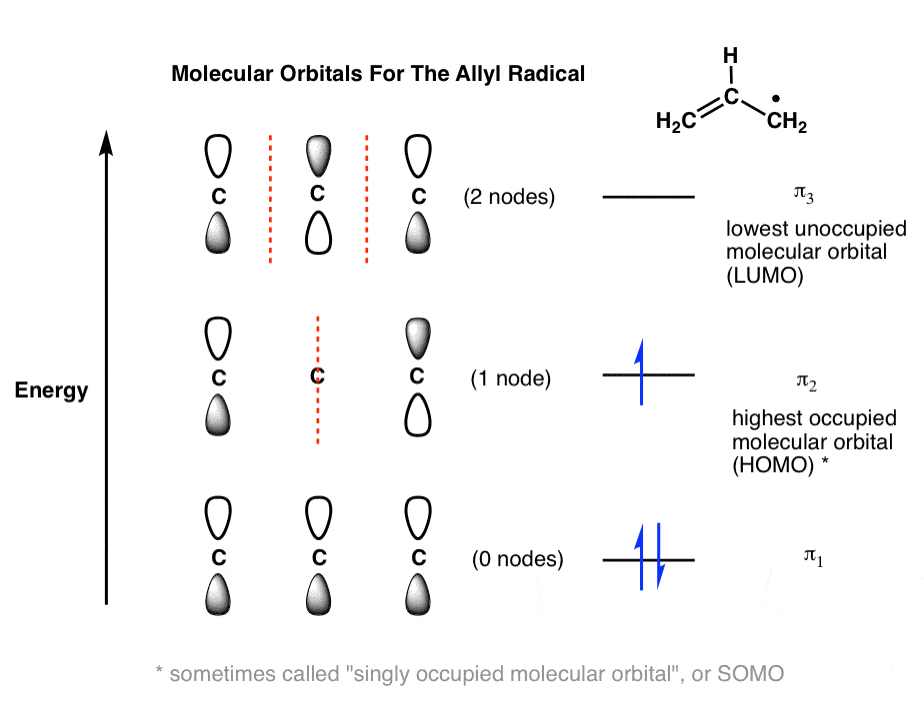
That gives us a half-filled π2, which is our new “HOMO”, and π3 now becomes our “LUMO”. [I don’t want to add to the confusion, but sometimes half-filled molecular orbitals like this are referred to as a “singly occupied molecular orbital”, or SOMO. Not super-important at this stage].
8. Molecular Orbitals of the Allyl Anion (4 pi electrons)
What about the allyl anion? Here we have 4 pi electrons: two in the pi bond, and two more as a lone pair on the terminal carbon. This fills up π2 .
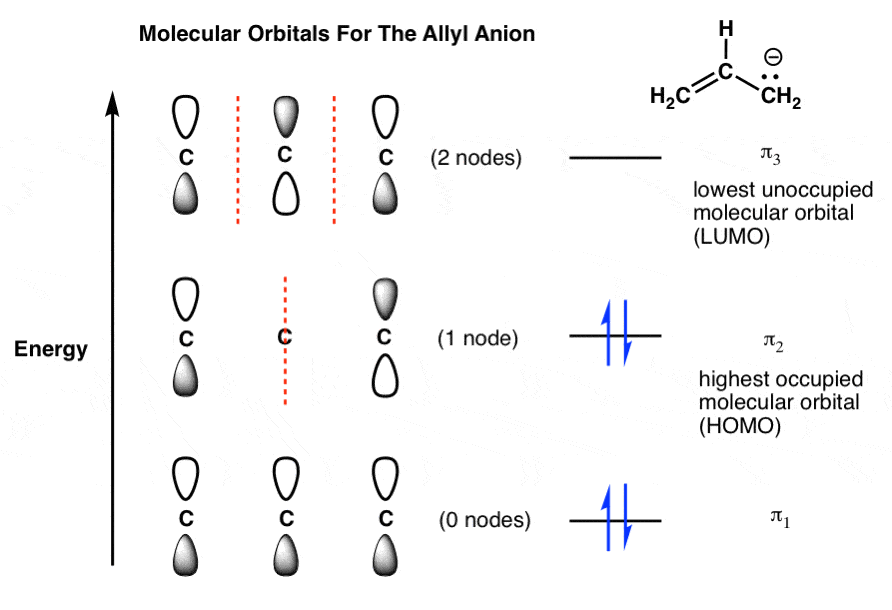
Our HOMO remains π2 and our LUMO remains π3 .
This satisfactorily shows the molecular orbitals for the allyl cation, radical, and anion.
9. Conclusion: The Allyl System
Here, we’ve shown how to extend the general principles of molecular orbitals we learned in building up the molecular orbitals of a pi bond (N=2) toward the allyl system (N=3). The key points are as follows:
- N atomic p orbitals give rise to N pi molecular orbitals
- The Nth molecular orbital will have N-1 nodes. (e.g. the 3rd MO in the allyl system has (3–1 = 2) nodes.
- When asked to draw molecular orbitals, a good rule of thumb is to start with the lowest-energy and highest-energy molecular orbitals. The lowest-energy molecular orbital has zero nodes (all p orbitals in phase) and the highest-energy molecular orbital will have (N-1) nodes (all p orbitals out of phase).
- Don’t add electrons to the system until you’ve drawn out all the molecular orbitals first.
In the next post, let’s look at the molecular orbitals for the butadienyl system (N=4).
Notes
Related Articles
Note 1. The rule of thumb that for “the Nth molecular orbital will have N-1 nodes” applies best to linear molecules. Cyclic molecules (such as benzene) follow the same general principles, but due to symmetry will have “nodal planes”. For example the lowest energy MO of benzene has zero nodes, but the next-highest energy level of benzene is “doubly degenerate” meaning that there are two ways to draw a single nodal plane. More here. We’ll cover this in a separate post.
Note 2. [An advanced note: one consequence of the node being in the centre of π2 is that the radical has zero electron density in the middle carbon (C-2). This is consistent with everything we’ve ever observed about the reactivity of allyl radicals – they react at the termini (C-1 or C-3), and never the middle carbon (C-2). ]
Note 3. Here’s a final (advanced) footnote, that only the extremely curious should look at. It’s showing how the 3 molecular orbitals of the allyl system are formed through interaction of two Pi molecular orbitals with a p orbital. This results in lowering of the energy of the π orbital (resulting in a stabilization of energy E) and raising of the energy of the π* orbital. The energy of the p orbital remains unchanged; intermediate in energy between bonding and antibonding, it is referred to as a “nonbonding” molecular orbital.
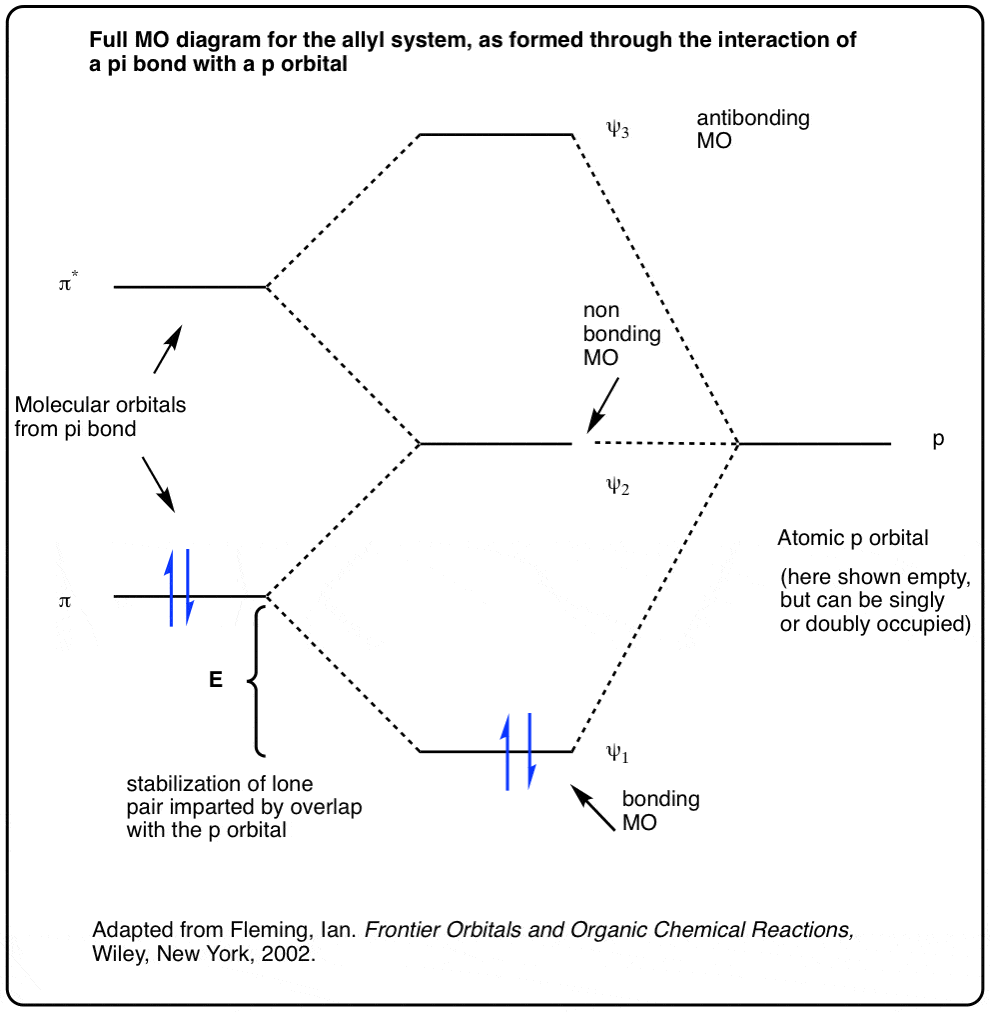
Adapted from Ian Fleming’s excellent “Frontier Orbitals and Organic Chemical Reactions”.
Note 4. Calculations on the allyl cation, radical, and anion courtesy of Rowan:
Allyl cation (source)
Calculated C–C bond length: 1.376 Å
Calculated C–C–C bond angle: 119.2°.
Allyl radical (source)
Calculated C–C bond lengths: 1.377 Å
Calculated C–C–C bond angle: 125.3°
Allyl anion: (source)
Calculated C–C bond length: 1.388 Å
Calculated C–C–C bond angle: 132.8°.
(Advanced) References and Further Reading
This topic is covered in several textbooks, and the best sources of information on this topic is books.
- Streitwieser, A., Jr. Molecular Orbital Theory for Organic Chemists; Wiley: New York, 1961.
- Fleming, I. Frontier Orbitals and Organic Chemical Reactions; Wiley: New York, 1991
- Streitweiser, A. Jr. Supplemental Tables of Molecular Orbital Calculations, Volume 2; Pergamon Press: Oxford, 1965
- Recognition of stereochemical paths by orbital interaction
Kenichi Fukui
Accounts of Chemical Research 1971 4 (2), 57-64
DOI: 10.1021/ar50038a003
This paper discusses the molecular orbitals of butadiene within the context of Frontier Molecular Orbital theory and the ‘Woodward-Hoffmann’ Rules. Prof. Fukui received the Nobel Prize in Chemistry in 1981 along with Prof. Roald Hoffmann for his contributions to the development of Frontier Molecular Orbital (FMO) theory. - 2. Examination of the energetic preference for coplanarity of double bonds. Comparison of butadiene, acrolein, and vinylamine
Kenneth B. Wiberg, Robert E. Rosenberg, and Paul R. Rablen
Journal of the American Chemical Society 1991, 113 (8), 2890-2898
DOI: 10.1021/ja00008a016
This paper examines the MO’s of butadiene and the isoelectronic molecules vinylamine and acrolein. Butadiene has a barrier to rotation along the C2-C3 bond, which is predicted by MO theory.
00 General Chemistry Review
01 Bonding, Structure, and Resonance
- How Do We Know Methane (CH4) Is Tetrahedral?
- Hybrid Orbitals and Hybridization
- How To Determine Hybridization: A Shortcut
- Orbital Hybridization And Bond Strengths
- Sigma bonds come in six varieties: Pi bonds come in one
- A Key Skill: How to Calculate Formal Charge
- The Four Intermolecular Forces and How They Affect Boiling Points
- 3 Trends That Affect Boiling Points
- How To Use Electronegativity To Determine Electron Density (and why NOT to trust formal charge)
- Introduction to Resonance
- How To Use Curved Arrows To Interchange Resonance Forms
- Evaluating Resonance Forms (1) - The Rule of Least Charges
- How To Find The Best Resonance Structure By Applying Electronegativity
- Evaluating Resonance Structures With Negative Charges
- Evaluating Resonance Structures With Positive Charge
- Exploring Resonance: Pi-Donation
- Exploring Resonance: Pi-acceptors
- In Summary: Evaluating Resonance Structures
- Drawing Resonance Structures: 3 Common Mistakes To Avoid
- How to apply electronegativity and resonance to understand reactivity
- Bond Hybridization Practice
- Structure and Bonding Practice Quizzes
- Resonance Structures Practice
02 Acid Base Reactions
- Introduction to Acid-Base Reactions
- Acid Base Reactions In Organic Chemistry
- The Stronger The Acid, The Weaker The Conjugate Base
- Walkthrough of Acid-Base Reactions (3) - Acidity Trends
- Five Key Factors That Influence Acidity
- Acid-Base Reactions: Introducing Ka and pKa
- How to Use a pKa Table
- The pKa Table Is Your Friend
- A Handy Rule of Thumb for Acid-Base Reactions
- Acid Base Reactions Are Fast
- pKa Values Span 60 Orders Of Magnitude
- How Protonation and Deprotonation Affect Reactivity
- Acid Base Practice Problems
03 Alkanes and Nomenclature
- Meet the (Most Important) Functional Groups
- Condensed Formulas: Deciphering What the Brackets Mean
- Hidden Hydrogens, Hidden Lone Pairs, Hidden Counterions
- Don't Be Futyl, Learn The Butyls
- Primary, Secondary, Tertiary, Quaternary In Organic Chemistry
- Branching, and Its Affect On Melting and Boiling Points
- The Many, Many Ways of Drawing Butane
- Wedge And Dash Convention For Tetrahedral Carbon
- Common Mistakes in Organic Chemistry: Pentavalent Carbon
- Table of Functional Group Priorities for Nomenclature
- Summary Sheet - Alkane Nomenclature
- Organic Chemistry IUPAC Nomenclature Demystified With A Simple Puzzle Piece Approach
- Boiling Point Quizzes
- Organic Chemistry Nomenclature Quizzes
04 Conformations and Cycloalkanes
- Staggered vs Eclipsed Conformations of Ethane
- Conformational Isomers of Propane
- Newman Projection of Butane (and Gauche Conformation)
- Introduction to Cycloalkanes
- Geometric Isomers In Small Rings: Cis And Trans Cycloalkanes
- Calculation of Ring Strain In Cycloalkanes
- Cycloalkanes - Ring Strain In Cyclopropane And Cyclobutane
- Cyclohexane Conformations
- Cyclohexane Chair Conformation: An Aerial Tour
- How To Draw The Cyclohexane Chair Conformation
- The Cyclohexane Chair Flip
- The Cyclohexane Chair Flip - Energy Diagram
- Substituted Cyclohexanes - Axial vs Equatorial
- Ranking The Bulkiness Of Substituents On Cyclohexanes: "A-Values"
- Cyclohexane Chair Conformation Stability: Which One Is Lower Energy?
- Fused Rings - Cis-Decalin and Trans-Decalin
- Naming Bicyclic Compounds - Fused, Bridged, and Spiro
- Bredt's Rule (And Summary of Cycloalkanes)
- Newman Projection Practice
- Cycloalkanes Practice Problems
05 A Primer On Organic Reactions
- The Most Important Question To Ask When Learning a New Reaction
- Curved Arrows (for reactions)
- Nucleophiles and Electrophiles
- The Three Classes of Nucleophiles
- Nucleophilicity vs. Basicity
- What Makes A Good Nucleophile?
- What Makes A Good Leaving Group?
- 3 Factors That Stabilize Carbocations
- Equilibrium and Energy Relationships
- 7 Factors that stabilize negative charge in organic chemistry
- 7 Factors That Stabilize Positive Charge in Organic Chemistry
- What's a Transition State?
- Hammond's Postulate
- Learning Organic Chemistry Reactions: A Checklist (PDF)
- Introduction to Oxidative Cleavage Reactions
06 Free Radical Reactions
- Free Radical Reactions
- 3 Factors That Stabilize Free Radicals
- Bond Strengths And Radical Stability
- Free Radical Initiation: Why Is "Light" Or "Heat" Required?
- Initiation, Propagation, Termination
- Monochlorination Products Of Propane, Pentane, And Other Alkanes
- Selectivity In Free Radical Reactions
- Selectivity in Free Radical Reactions: Bromination vs. Chlorination
- Halogenation At Tiffany's
- Allylic Bromination
- Bonus Topic: Allylic Rearrangements
- In Summary: Free Radicals
- Synthesis (2) - Reactions of Alkanes
- Free Radicals Practice Quizzes
07 Stereochemistry and Chirality
- Types of Isomers: Constitutional Isomers, Stereoisomers, Enantiomers, and Diastereomers
- How To Draw The Enantiomer Of A Chiral Molecule
- How To Draw A Bond Rotation
- Introduction to Assigning (R) and (S): The Cahn-Ingold-Prelog Rules
- Assigning Cahn-Ingold-Prelog (CIP) Priorities (2) - The Method of Dots
- Enantiomers vs Diastereomers vs The Same? Two Methods For Solving Problems
- Assigning R/S To Newman Projections (And Converting Newman To Line Diagrams)
- How To Determine R and S Configurations On A Fischer Projection
- The Meso Trap
- Optical Rotation, Optical Activity, and Specific Rotation
- Optical Purity and Enantiomeric Excess
- What's a Racemic Mixture?
- Chiral Allenes And Chiral Axes
- Stereochemistry Practice Problems and Quizzes
08 Substitution Reactions
- Nucleophilic Substitution Reactions - Introduction
- Two Types of Nucleophilic Substitution Reactions
- The SN2 Mechanism
- Why the SN2 Reaction Is Powerful
- The SN1 Mechanism
- The Conjugate Acid Is A Better Leaving Group
- Comparing the SN1 and SN2 Reactions
- Polar Protic? Polar Aprotic? Nonpolar? All About Solvents
- Steric Hindrance is Like a Fat Goalie
- Common Blind Spot: Intramolecular Reactions
- Substitution Practice - SN1
- Substitution Practice - SN2
09 Elimination Reactions
- Elimination Reactions (1): Introduction And The Key Pattern
- Elimination Reactions (2): The Zaitsev Rule
- Elimination Reactions Are Favored By Heat
- Two Elimination Reaction Patterns
- The E1 Reaction
- The E2 Mechanism
- E1 vs E2: Comparing the E1 and E2 Reactions
- Antiperiplanar Relationships: The E2 Reaction and Cyclohexane Rings
- Bulky Bases in Elimination Reactions
- Comparing the E1 vs SN1 Reactions
- Elimination (E1) Reactions With Rearrangements
- E1cB - Elimination (Unimolecular) Conjugate Base
- Elimination (E1) Practice Problems And Solutions
- Elimination (E2) Practice Problems and Solutions
10 Rearrangements
11 SN1/SN2/E1/E2 Decision
- Identifying Where Substitution and Elimination Reactions Happen
- Deciding SN1/SN2/E1/E2 (1) - The Substrate
- Deciding SN1/SN2/E1/E2 (2) - The Nucleophile/Base
- SN1 vs E1 and SN2 vs E2 : The Temperature
- Deciding SN1/SN2/E1/E2 - The Solvent
- Wrapup: The Key Factors For Determining SN1/SN2/E1/E2
- Alkyl Halide Reaction Map And Summary
- SN1 SN2 E1 E2 Practice Problems
12 Alkene Reactions
- E and Z Notation For Alkenes (+ Cis/Trans)
- Alkene Stability
- Alkene Addition Reactions: "Regioselectivity" and "Stereoselectivity" (Syn/Anti)
- Stereoselective and Stereospecific Reactions
- Hydrohalogenation of Alkenes and Markovnikov's Rule
- Hydration of Alkenes With Aqueous Acid
- Rearrangements in Alkene Addition Reactions
- Halogenation of Alkenes and Halohydrin Formation
- Oxymercuration Demercuration of Alkenes
- Hydroboration Oxidation of Alkenes
- m-CPBA (meta-chloroperoxybenzoic acid)
- OsO4 (Osmium Tetroxide) for Dihydroxylation of Alkenes
- Palladium on Carbon (Pd/C) for Catalytic Hydrogenation of Alkenes
- Cyclopropanation of Alkenes
- A Fourth Alkene Addition Pattern - Free Radical Addition
- Alkene Reactions: Ozonolysis
- Summary: Three Key Families Of Alkene Reaction Mechanisms
- Synthesis (4) - Alkene Reaction Map, Including Alkyl Halide Reactions
- Alkene Reactions Practice Problems
13 Alkyne Reactions
- Acetylides from Alkynes, And Substitution Reactions of Acetylides
- Partial Reduction of Alkynes With Lindlar's Catalyst
- Partial Reduction of Alkynes With Na/NH3 To Obtain Trans Alkenes
- Alkyne Hydroboration With "R2BH"
- Hydration and Oxymercuration of Alkynes
- Hydrohalogenation of Alkynes
- Alkyne Halogenation: Bromination and Chlorination of Alkynes
- Oxidation of Alkynes With O3 and KMnO4
- Alkenes To Alkynes Via Halogenation And Elimination Reactions
- Alkynes Are A Blank Canvas
- Synthesis (5) - Reactions of Alkynes
- Alkyne Reactions Practice Problems With Answers
14 Alcohols, Epoxides and Ethers
- Alcohols - Nomenclature and Properties
- Alcohols Can Act As Acids Or Bases (And Why It Matters)
- Alcohols - Acidity and Basicity
- The Williamson Ether Synthesis
- Ethers From Alkenes, Tertiary Alkyl Halides and Alkoxymercuration
- Alcohols To Ethers via Acid Catalysis
- Cleavage Of Ethers With Acid
- Epoxides - The Outlier Of The Ether Family
- Opening of Epoxides With Acid
- Epoxide Ring Opening With Base
- Making Alkyl Halides From Alcohols
- Tosylates And Mesylates
- PBr3 and SOCl2
- Elimination Reactions of Alcohols
- Elimination of Alcohols To Alkenes With POCl3
- Alcohol Oxidation: "Strong" and "Weak" Oxidants
- Demystifying The Mechanisms of Alcohol Oxidations
- Protecting Groups For Alcohols
- Thiols And Thioethers
- Calculating the oxidation state of a carbon
- Oxidation and Reduction in Organic Chemistry
- Oxidation Ladders
- SOCl2 Mechanism For Alcohols To Alkyl Halides: SN2 versus SNi
- Alcohol Reactions Roadmap (PDF)
- Alcohol Reaction Practice Problems
- Epoxide Reaction Quizzes
- Oxidation and Reduction Practice Quizzes
15 Organometallics
- What's An Organometallic?
- Formation of Grignard and Organolithium Reagents
- Organometallics Are Strong Bases
- Reactions of Grignard Reagents
- Protecting Groups In Grignard Reactions
- Synthesis Problems Involving Grignard Reagents
- Grignard Reactions And Synthesis (2)
- Organocuprates (Gilman Reagents): How They're Made
- Gilman Reagents (Organocuprates): What They're Used For
- The Heck, Suzuki, and Olefin Metathesis Reactions (And Why They Don't Belong In Most Introductory Organic Chemistry Courses)
- Reaction Map: Reactions of Organometallics
- Grignard Practice Problems
16 Spectroscopy
- Degrees of Unsaturation (or IHD, Index of Hydrogen Deficiency)
- Conjugation And Color (+ How Bleach Works)
- Introduction To UV-Vis Spectroscopy
- UV-Vis Spectroscopy: Absorbance of Carbonyls
- UV-Vis Spectroscopy: Practice Questions
- Bond Vibrations, Infrared Spectroscopy, and the "Ball and Spring" Model
- Infrared Spectroscopy: A Quick Primer On Interpreting Spectra
- IR Spectroscopy: 4 Practice Problems
- 1H NMR: How Many Signals?
- Homotopic, Enantiotopic, Diastereotopic
- Diastereotopic Protons in 1H NMR Spectroscopy: Examples
- 13-C NMR - How Many Signals
- Liquid Gold: Pheromones In Doe Urine
- Natural Product Isolation (1) - Extraction
- Natural Product Isolation (2) - Purification Techniques, An Overview
- Structure Determination Case Study: Deer Tarsal Gland Pheromone
17 Dienes and MO Theory
- What To Expect In Organic Chemistry 2
- Are these molecules conjugated?
- Conjugation And Resonance In Organic Chemistry
- Bonding And Antibonding Pi Orbitals
- Molecular Orbitals of The Allyl Cation, Allyl Radical, and Allyl Anion
- Pi Molecular Orbitals of Butadiene
- Reactions of Dienes: 1,2 and 1,4 Addition
- Thermodynamic and Kinetic Products
- More On 1,2 and 1,4 Additions To Dienes
- s-cis and s-trans
- The Diels-Alder Reaction
- Cyclic Dienes and Dienophiles in the Diels-Alder Reaction
- Stereochemistry of the Diels-Alder Reaction
- Exo vs Endo Products In The Diels Alder: How To Tell Them Apart
- HOMO and LUMO In the Diels Alder Reaction
- Why Are Endo vs Exo Products Favored in the Diels-Alder Reaction?
- Diels-Alder Reaction: Kinetic and Thermodynamic Control
- The Retro Diels-Alder Reaction
- The Intramolecular Diels Alder Reaction
- Regiochemistry In The Diels-Alder Reaction
- The Cope and Claisen Rearrangements
- Electrocyclic Reactions
- Electrocyclic Ring Opening And Closure (2) - Six (or Eight) Pi Electrons
- Diels Alder Practice Problems
- Molecular Orbital Theory Practice
18 Aromaticity
- Introduction To Aromaticity
- Rules For Aromaticity
- Huckel's Rule: What Does 4n+2 Mean?
- Aromatic, Non-Aromatic, or Antiaromatic? Some Practice Problems
- Antiaromatic Compounds and Antiaromaticity
- The Pi Molecular Orbitals of Benzene
- The Pi Molecular Orbitals of Cyclobutadiene
- Frost Circles
- Aromaticity Practice Quizzes
19 Reactions of Aromatic Molecules
- Electrophilic Aromatic Substitution: Introduction
- Activating and Deactivating Groups In Electrophilic Aromatic Substitution
- Electrophilic Aromatic Substitution - The Mechanism
- Ortho-, Para- and Meta- Directors in Electrophilic Aromatic Substitution
- Understanding Ortho, Para, and Meta Directors
- Why are halogens ortho- para- directors?
- Disubstituted Benzenes: The Strongest Electron-Donor "Wins"
- Electrophilic Aromatic Substitutions (1) - Halogenation of Benzene
- Electrophilic Aromatic Substitutions (2) - Nitration and Sulfonation
- EAS Reactions (3) - Friedel-Crafts Acylation and Friedel-Crafts Alkylation
- Intramolecular Friedel-Crafts Reactions
- Nucleophilic Aromatic Substitution (NAS)
- Nucleophilic Aromatic Substitution (2) - The Benzyne Mechanism
- Reactions on the "Benzylic" Carbon: Bromination And Oxidation
- The Wolff-Kishner, Clemmensen, And Other Carbonyl Reductions
- More Reactions on the Aromatic Sidechain: Reduction of Nitro Groups and the Baeyer Villiger
- Aromatic Synthesis (1) - "Order Of Operations"
- Synthesis of Benzene Derivatives (2) - Polarity Reversal
- Aromatic Synthesis (3) - Sulfonyl Blocking Groups
- Birch Reduction
- Synthesis (7): Reaction Map of Benzene and Related Aromatic Compounds
- Aromatic Reactions and Synthesis Practice
- Electrophilic Aromatic Substitution Practice Problems
20 Aldehydes and Ketones
- What's The Alpha Carbon In Carbonyl Compounds?
- Nucleophilic Addition To Carbonyls
- Aldehydes and Ketones: 14 Reactions With The Same Mechanism
- Sodium Borohydride (NaBH4) Reduction of Aldehydes and Ketones
- Grignard Reagents For Addition To Aldehydes and Ketones
- Wittig Reaction
- Hydrates, Hemiacetals, and Acetals
- Imines - Properties, Formation, Reactions, and Mechanisms
- All About Enamines
- Breaking Down Carbonyl Reaction Mechanisms: Reactions of Anionic Nucleophiles (Part 2)
- Aldehydes Ketones Reaction Practice
21 Carboxylic Acid Derivatives
- Nucleophilic Acyl Substitution (With Negatively Charged Nucleophiles)
- Addition-Elimination Mechanisms With Neutral Nucleophiles (Including Acid Catalysis)
- Basic Hydrolysis of Esters - Saponification
- Transesterification
- Proton Transfer
- Fischer Esterification - Carboxylic Acid to Ester Under Acidic Conditions
- Lithium Aluminum Hydride (LiAlH4) For Reduction of Carboxylic Acid Derivatives
- LiAlH[Ot-Bu]3 For The Reduction of Acid Halides To Aldehydes
- Di-isobutyl Aluminum Hydride (DIBAL) For The Partial Reduction of Esters and Nitriles
- Amide Hydrolysis
- Thionyl Chloride (SOCl2) And Conversion of Carboxylic Acids to Acid Halides
- Diazomethane (CH2N2)
- Carbonyl Chemistry: Learn Six Mechanisms For the Price Of One
- Making Music With Mechanisms (PADPED)
- Carboxylic Acid Derivatives Practice Questions
22 Enols and Enolates
- Keto-Enol Tautomerism
- Enolates - Formation, Stability, and Simple Reactions
- Kinetic Versus Thermodynamic Enolates
- Aldol Addition and Condensation Reactions
- Reactions of Enols - Acid-Catalyzed Aldol, Halogenation, and Mannich Reactions
- Claisen Condensation and Dieckmann Condensation
- Decarboxylation
- The Malonic Ester and Acetoacetic Ester Synthesis
- The Michael Addition Reaction and Conjugate Addition
- The Robinson Annulation
- Haloform Reaction
- The Hell–Volhard–Zelinsky Reaction
- Enols and Enolates Practice Quizzes
23 Amines
- The Amide Functional Group: Properties, Synthesis, and Nomenclature
- Basicity of Amines And pKaH
- 5 Key Basicity Trends of Amines
- The Mesomeric Effect And Aromatic Amines
- Nucleophilicity of Amines
- Alkylation of Amines (Sucks!)
- Reductive Amination
- The Gabriel Synthesis
- Some Reactions of Azides
- The Hofmann Elimination
- The Hofmann and Curtius Rearrangements
- The Cope Elimination
- Protecting Groups for Amines - Carbamates
- The Strecker Synthesis of Amino Acids
- Introduction to Peptide Synthesis
- Reactions of Diazonium Salts: Sandmeyer and Related Reactions
- Amine Practice Questions
24 Carbohydrates
- D and L Notation For Sugars
- Pyranoses and Furanoses: Ring-Chain Tautomerism In Sugars
- What is Mutarotation?
- Reducing Sugars
- The Big Damn Post Of Carbohydrate-Related Chemistry Definitions
- The Haworth Projection
- Converting a Fischer Projection To A Haworth (And Vice Versa)
- Reactions of Sugars: Glycosylation and Protection
- The Ruff Degradation and Kiliani-Fischer Synthesis
- Isoelectric Points of Amino Acids (and How To Calculate Them)
- Carbohydrates Practice
- Amino Acid Quizzes
25 Fun and Miscellaneous
- A Gallery of Some Interesting Molecules From Nature
- Screw Organic Chemistry, I'm Just Going To Write About Cats
- On Cats, Part 1: Conformations and Configurations
- On Cats, Part 2: Cat Line Diagrams
- On Cats, Part 4: Enantiocats
- On Cats, Part 6: Stereocenters
- Organic Chemistry Is Shit
- The Organic Chemistry Behind "The Pill"
- Maybe they should call them, "Formal Wins" ?
- Why Do Organic Chemists Use Kilocalories?
- The Principle of Least Effort
- Organic Chemistry GIFS - Resonance Forms
- Reproducibility In Organic Chemistry
- What Holds The Nucleus Together?
- How Reactions Are Like Music
- Organic Chemistry and the New MCAT
26 Organic Chemistry Tips and Tricks
- Common Mistakes: Formal Charges Can Mislead
- Partial Charges Give Clues About Electron Flow
- Draw The Ugly Version First
- Organic Chemistry Study Tips: Learn the Trends
- The 8 Types of Arrows In Organic Chemistry, Explained
- Top 10 Skills To Master Before An Organic Chemistry 2 Final
- Common Mistakes with Carbonyls: Carboxylic Acids... Are Acids!
- Planning Organic Synthesis With "Reaction Maps"
- Alkene Addition Pattern #1: The "Carbocation Pathway"
- Alkene Addition Pattern #2: The "Three-Membered Ring" Pathway
- Alkene Addition Pattern #3: The "Concerted" Pathway
- Number Your Carbons!
- The 4 Major Classes of Reactions in Org 1
- How (and why) electrons flow
- Grossman's Rule
- Three Exam Tips
- A 3-Step Method For Thinking Through Synthesis Problems
- Putting It Together
- Putting Diels-Alder Products in Perspective
- The Ups and Downs of Cyclohexanes
- The Most Annoying Exceptions in Org 1 (Part 1)
- The Most Annoying Exceptions in Org 1 (Part 2)
- The Marriage May Be Bad, But the Divorce Still Costs Money
- 9 Nomenclature Conventions To Know
- Nucleophile attacks Electrophile
27 Case Studies of Successful O-Chem Students
- Success Stories: How Corina Got The The "Hard" Professor - And Got An A+ Anyway
- How Helena Aced Organic Chemistry
- From a "Drop" To B+ in Org 2 – How A Hard Working Student Turned It Around
- How Serge Aced Organic Chemistry
- Success Stories: How Zach Aced Organic Chemistry 1
- Success Stories: How Kari Went From C– to B+
- How Esther Bounced Back From a "C" To Get A's In Organic Chemistry 1 And 2
- How Tyrell Got The Highest Grade In Her Organic Chemistry Course
- This Is Why Students Use Flashcards
- Success Stories: How Stu Aced Organic Chemistry
- How John Pulled Up His Organic Chemistry Exam Grades
- Success Stories: How Nathan Aced Organic Chemistry (Without It Taking Over His Life)
- How Chris Aced Org 1 and Org 2
- Interview: How Jay Got an A+ In Organic Chemistry
- How to Do Well in Organic Chemistry: One Student's Advice
- "America's Top TA" Shares His Secrets For Teaching O-Chem
- "Organic Chemistry Is Like..." - A Few Metaphors
- How To Do Well In Organic Chemistry: Advice From A Tutor
- Guest post: "I went from being afraid of tests to actually looking forward to them".
Extending the logic from note 2: when looking at pentadienyl cation. The electrons in pi-1 have no nodes so they delocalized along the entire chain. In pi-2, we have a pair with one node. Would we say that the electrons are delocalized at c1-c2 OR c4-c5? I guess I am asking if the nodes tell us where the electrons are delocalized?
I am confused between the MO diagram of allyl system using atomic p orbitals given first and the full MO diagram given in the last.
The first shows you the three energy levels and the phases of the p-orbitals within them. The second fills it with electrons.
It’s this second factor that ultimately determines which of the three pi molecular orbitals is the highest-occupied molecular orbital (HOMO) or lowest unoccupied molecular orbital (LUMO).
This website is quickly becoming one of my favourites. I love seeing complex subjects like this explained so effectively!
I’m assuming I’m missing something obvious as I wasn’t able to find this question posed anywhere else, so I’m hoping a kind reader might be able to help me here.
I was under the impression that to find the hybridisation of an atom, you could use the steric number (# of sigma bonds + # of lone pairs). If we do this for the allyl anion though, we’d get a SN of 4 (1 LP and 3 sigma bonds), corresponding to sp3 hybridisation. But if this were the case, we wouldn’t have the available p orbital to give us the resonance structure…
Right. The lone pair would be in an sp3 orbital, and the overlap of the sp3 orbtial with the adjacent p-orbitals isn’t as good. Re-hybridization of the sp3 orbital to p gives a lower energy structure.
Out of the cation, radical, and anion allylic carbons, which is the most stable in terms of energy? I’ve been looking around, but I can’t quite seem to find the answer ton this.
It is difficult to compare the relative stabilities of anions, cations, and radicals. It really is like comparing apples, oranges, and bananas. It’s much easier to compare anions relative to other anions, cations to other cations, etc.
I meant C1 and C3 by end carbon atoms sir,sorry for mistyping
sir,i have a question for you(may seem silly though)..In the allyl anion or radical system,it is said that two electrons in anion and one electron in radical respectively(in reference to non-bonding orbitals) is shared by end carbon atoms (C2 and C3)..How is it possible if there is node in the middle carbon between them?please clear my doubt sir
thankyou for giving such detailed answer and explaining in a simple way :)
Sir,from the molecular orbital diagrams of the allylic systems,what can we say about the stability order of allylic cation,radical and anion?
On what basis do we decide this order?
It is difficult to compare the relative stabilities of anions, cations, and radicals. It really is like comparing apples, oranges, and bananas. It’s much easier to compare anions relative to other anions, cations to other cations, etc.
Thank you very much Sir for these lovely explanations!
Thank you so much for your quick response. You’re right, I did mean allene and I’m quite familiar with it’s structure. What I was wondering was whether the molecular orbitals formed from the atomic orbitals will exist independently and whether they will also be perpendicular to each other.
Yes, they will exist independently and yes, they will be perpendicular to each other. In essence they operate like two independent pi bonds.
I’m wondering if propadiene has molecular orbitals similar to 1,3 butadiene. I know that propadiene has a twisted structure, but I don’t get why none of the sites mention it’s molecular orbitals. I understood this article quite well but I’m just really curious about propadiene for some reason. Can you please help me understand this?
Do you mean, “Allene” ? It has two pi bonds at right angles to each other. https://www.masterorganicchemistry.com/2015/01/13/chiral-allenes-and-chiral-axes/
Really great explanation!
OK, thank you Peter, glad you found it helpful!
Thanks a lot Sir for a really helpful post ….. easy to understand yet difficult to find out in ordinary textbooks.